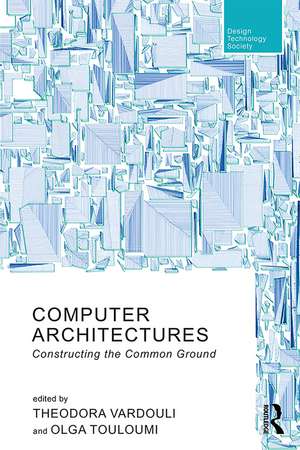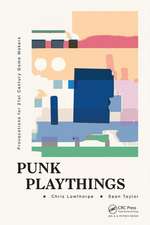Computer Architectures: Constructing the Common Ground: Routledge Research in Design, Technology and Society
Editat de Theodora Vardouli, Olga Touloumien Limba Engleză Hardback – 14 noi 2019
Weaving together intellectual, social, cultural, and material histories, this book paints the landscape that brought computing into the imagination, production, and management of the built environment, whilst foregrounding the impact of architecture in shaping technological development. The book is organized into sections corresponding to the classic von Neumann diagram for computer architecture: program (control unit), storage (memory), input/output and computation (arithmetic/logic unit), each acting as a quasi-material category for parsing debates among architects, engineers, mathematicians, and technologists. Collectively, authors bring forth the striking homologies between a computer program and an architectural program, a wall and an interface, computer memory and storage architectures, structures of mathematics and structures of things. The collection initiates new histories of knowledge and technology production that turn an eye toward disciplinary fusions and their institutional and intellectual drives.
Constructing the common ground between design and computing, this collection addresses audiences working at the nexus of design, technology, and society, including historians and practitioners of design and architecture, science and technology scholars, and media studies scholars.
| Toate formatele și edițiile | Preț | Express |
|---|---|---|
| Paperback (1) | 320.34 lei 3-5 săpt. | +27.56 lei 7-13 zile |
| Taylor & Francis – 30 iun 2021 | 320.34 lei 3-5 săpt. | +27.56 lei 7-13 zile |
| Hardback (1) | 765.84 lei 6-8 săpt. | |
| Taylor & Francis – 14 noi 2019 | 765.84 lei 6-8 săpt. |
Preț: 765.84 lei
Preț vechi: 1103.72 lei
-31% Nou
Puncte Express: 1149
Preț estimativ în valută:
146.54€ • 153.00$ • 121.28£
146.54€ • 153.00$ • 121.28£
Carte tipărită la comandă
Livrare economică 05-19 aprilie
Preluare comenzi: 021 569.72.76
Specificații
ISBN-13: 9780815396529
ISBN-10: 081539652X
Pagini: 244
Ilustrații: 68
Dimensiuni: 156 x 234 mm
Greutate: 0.54 kg
Ediția:1
Editura: Taylor & Francis
Colecția Routledge
Seria Routledge Research in Design, Technology and Society
Locul publicării:Oxford, United Kingdom
ISBN-10: 081539652X
Pagini: 244
Ilustrații: 68
Dimensiuni: 156 x 234 mm
Greutate: 0.54 kg
Ediția:1
Editura: Taylor & Francis
Colecția Routledge
Seria Routledge Research in Design, Technology and Society
Locul publicării:Oxford, United Kingdom
Public țintă
PostgraduateCuprins
1. Introduction: Toward a Polyglot Space PART I PROGRAM 2. Computing Environmental Design 3. The Work of Design and the Design of Work: Olivetti and the Political Economy of its Early Computers 4. "Bewildered, the Form-Maker Stands Alone": Computer Architecture and the Quest for Design Rationality PART II INPUT/OUTPUT 5. Augmentation and Interface: Tracing a Spectrum 6. The First Failure of Man-Computer Symbiosis: The Hospital Computer Project, 1960-1968 7. The Unclean Human-Machine Interface PART III STORAGE 8. Architectures of Information: A Comparison of Wiener’s and Shannon’s Theories of Information 9. Bureaucracy’s Playthings PART IV COMPUTATION 10. Imagining Architecture as a Form of Concrete Poetry 11. The Axiomatic Aesthetic
Notă biografică
Theodora Vardouli is Assistant Professor at the Peter Guo-hua Fu School of Architecture, McGill University, Canada.
Olga Touloumi is Assistant Professor of Architectural History at Bard College, USA.
Olga Touloumi is Assistant Professor of Architectural History at Bard College, USA.
Recenzii
"This impressive collection brings together a stellar group of thinkers from diverse disciplinary traditions to explore the deeply intertwined histories of architecture and computation. It’s a model for studies of computation as a cultural, as well as technical, practice." - Jennifer S. Light, Professor of Urban Studies and Planning, Massachusetts Institute of Technology
Descriere
Computer Architectures is a collection of multidisciplinary historical works that unearth sites, concepts, and concerns that catalyzed the cross-contamination of computers and architecture in the mid-20th century.

































